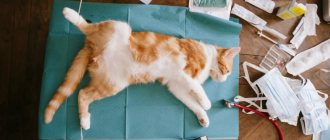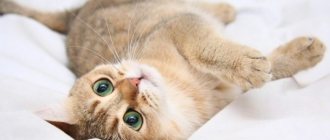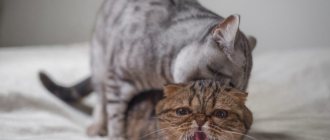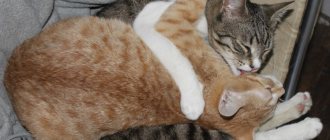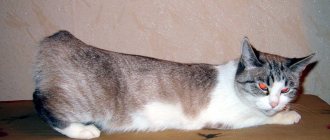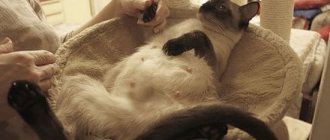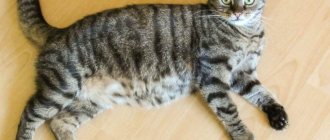Cute and affectionate kittens are welcome guests in almost any home. You can watch their games and behavior endlessly. But as soon as the cats grow up a little, the fairy tale gradually begins to become scary. To save yourself from unpleasant surprises, you need to know exactly at what age cats begin to walk.
It should be noted that in these animals, depending on their sex, maturation occurs at different times. Girls, as a rule, reach the age of readiness to go out earlier than boys. If the former can demand “romance” already at six to seven months, then the latter begin to be interested in the opposite sex only at eight to ten months.
It is impossible to confuse the moment when a cat begins to walk for the first time, since the animal’s behavior changes dramatically.
Yesterday's kitten, upon entering childbearing age, stops cuddling and becomes aggressive and angry. The animal may begin to throw itself at its owners, scratch itself, and strive to leave the house, going for a walk in search of adventure outside the door.
© shutterstock
Puberty of cats: castration or hormonal drugs
Almost all cat owners one day notice that something strange is happening to their pet. Their sweet and playful kitten behaves differently than usual, doing things that leave them in amazement and even indignation.
What happened? The kitten just became an adult.
What is puberty
Animals, like humans, enter puberty, when the body's hormonal levels change and it becomes ready for reproduction. In cats it occurs at 7-8 months and sexual heat begins. By human standards, this is 7-10 years, but unlike humans, animals at this age are already ready to mate. Cats begin to go into heat, repeating every 3-4 weeks, the cat needs a female, and constantly.
Signs of heat
During the period of sexual hunting, the behavior and character of the pet changes greatly. There are many signs that an animal needs mating:
- both male and female cats become aggressive;
- scream (meow invitingly), especially at night;
- cats begin to mark their territory (i.e., leave urine marks throughout the house);
- cats become intrusive, constantly rub against the owner or pieces of furniture, walk on half-bent legs, raising their butts, their tail is constantly raised;
- animals tend to go outside (even those who have never been there);
- become disobedient and may start doing dirty tricks;
- cats often refuse to eat.
If in a cat these symptoms appear and last only during the period of estrus, then in cats the sexual heat lasts a whole year, which means that screams, marks and other “charms” of sexual heat will constantly torment the owners. Moreover, even if you bring a cat together with a cat, this will not discourage him and will not “make him sad.”
Both male and female cats suffer if mating does not occur, so owners need to solve this problem as quickly as possible. And there are three ways to solve it:
- provide animals with complete freedom and access to the street (or constantly bring the animals together);
- spay or neuter your pet;
- Constantly give the animal hormonal drugs that reduce libido.
The first option is not suitable for everyone: complete freedom of the animal is fraught with consequences (lichen, worms, fleas, various diseases that the pet brings from the street), and the kittens will need to be placed somewhere. Therefore, the choice is mainly between castration (sterilization) and drugs.
Pros and cons of castration (sterilization)
A very common and effective way to neutralize the animal's need to mate and reproduce. These procedures are performed surgically. Moreover, castration and sterilization are radically different.
Sterilization is considered more humane and safe than castration. Animals of both sexes can be sterilized, but it is more suitable for cats. The essence of this operation is to ligate the fallopian tubes in cats and the seminal canals in cats, that is, the reproductive organs of the animals are not removed. Sterilization only results in the inability to reproduce, but does not prevent the release of sex hormones, and therefore does not solve behavioral problems.
In addition, sterilization also has a number of negative consequences:
- the risk of breast and testicular cancer increases;
- problems with the urinary system may appear;
- Animals may also experience prostatitis and inflammation of the uterus.
Castration is a radical method; during this operation, the seminal glands are completely removed in cats, and the uterus and ovaries in cats. Although this method seems cruel, it is very effective. Since the organs responsible for the production of sex hormones are removed, all problems associated with the pet’s behavior disappear. He becomes affectionate and calm again. In addition, thanks to the castration procedure, the animal’s lifespan increases, its mental abilities increase, and the risk of diseases of the genitourinary system decreases. But there are several reasons why owners are afraid to subject their pets to this procedure:
- obesity may develop;
- the animal may not tolerate anesthesia;
- there is a risk of kidney stones;
- Heart disease develops with poor diet.
Hormonal drugs to reduce libido
Recently, more and more cat owners are inclined to solve the problems of sexual heat with the help of special medications, which are available in the form of tablets or drops. Indeed, this method allows you to avoid surgical intervention in the pet’s body and the associated consequences (what it takes for the animal to survive anesthesia). A lot of pharmaceutical companies produce such drugs, the choice is great and the price is also different. But it is important to understand that the cheaper the medicine, the more contraindications and side effects it has (cheap cannot be good).
Manifestations of physical maturity
Once they reach puberty, cats begin to behave much more aggressively than male cats. This is expressed in loud screams at night, damage to furniture and wallpaper, and marks throughout the habitat of an animal that has reached a dangerous age. During the period of estrus, the urine of an animal acquires a very pungent and unpleasant odor , it is almost impossible to get rid of it - these are very clear signs of the cat’s puberty. In addition, the beast constantly updates its marks.
The behavior of an animal depends quite strongly on the presence of competitors near it. The more aggressors around, the more nervous the cat began to behave. He hisses and grumbles threateningly, his games resemble hunting.
A loud voice is one way to show rivals who is boss in the house, especially if two animals are in a one-on-one duel.
It should be noted that in addition to being a threat to competitors, cat cries may not be a very good sign. This behavior may be a consequence of the formation of kidney stones in the pet , and not because it has reached a certain age. The sharp edges painfully wound the animal from the inside, causing it to literally scream in pain. That is why any pet’s complaints should be treated carefully and not confuse estrus with a serious problem.
© shutterstock
Always ready! The cat wants a cat all year round
Many owners, when getting a pet, choose a cat. It is believed that keeping a male animal is much easier than a cat, mainly because you do not have to solve the problem of finding homes for the kittens that are born. However, another problem arises related to his sexual desire. Not everyone knows that a cat is ready to meet a cat at any time of the year.
Puberty in cats ends at the age of 8-10 months. The time of puberty depends on the breed of the animal and the conditions under which it is kept. After the end of puberty, the cat can breed at any time and will be distinguished by demanding behavior.
When a cat is ready to mate, his body obeys natural instincts. Therefore, it is impossible to re-educate a cat that requires a cat.
What determines the maturation of an animal?
It is worth noting that it is impossible to say with absolute certainty that a cat begins to walk at 8 months , since, like in people, in cats this process occurs with individual characteristics, in which age is not the main indicator. It’s easier to focus on some general rules:
- The age of maturation depends on the breed, some of them cause earlier or later onset of sexual heat;
- This factor is also influenced by the structure of the skeleton; more fragile and graceful animals are earlier ready for reproduction;
- The time of birth also influences puberty; a cat reaches sexual maturity from a winter or spring litter as early as the next season, while later-born animals may take a little longer to mature;
- Cats kept in the most comfortable conditions are ready to give birth to offspring much earlier;
- An animal that finds itself in an environment consisting mainly of adult animals will itself mature faster;
- In many animals, the early search for satisfaction of their needs is explained by a common genetic predisposition.
In any case, when the age gets closer to a year, any animal will already begin to show signs indicating the onset of childbearing age.
How to determine that a cat wants a cat?
The owner of the animal can immediately understand when the cat begins to ask for a cat, because the pet’s behavior becomes completely different. The onset of puberty in a cat can be determined by the following signs:
- Marking the territory. Cats that have reached puberty leave marks in the apartment: on walls, doors, upholstered furniture. In this way, they attract females for mating and make it clear to possible rivals that the territory is occupied;
- Aggressive behavior towards owners and other animals. Unfriendly behavior in cats during heat can sometimes pose a danger to household members. Owners run the risk of being scratched or bitten. It is difficult to call such a cat cute and fluffy; it will not be possible to change his behavior with the help of educational measures;
- Calling cries. The cat is trying to attract the cat's attention with loud screams. In this case, the shrill meowing can continue for hours, day and night. It is also practically impossible to influence such behavior with educational measures;
- Constant desire to run outside. Driven by the instinct of reproduction, the cat always pays attention to doors and windows. At the first convenient opportunity, the pet is ready to jump out of the apartment in search of the cat.
Some breeders and cat owners use special sprays to avoid tags splashing and eliminate odor if they appear. Such products can be found at any pet store. But the spray can only cope with the problem of marks; it is impossible to eliminate unwanted behavior (aggression and screaming) with its help.
Efficiency
The drug Gestrenol effectively reduces sexual arousal in cats: it eliminates problems of marking territory, aggressive and demanding behavior. With regular use of the drug, sexual tranquility of the animal is ensured.
Convenience
The drug is available in the form of drops. This is the most convenient form for cats to use. Gestrenol drops contain catnip, which attracts animals with its smell and taste. This allows you to use drops for cats without any extra effort.
| Problem | Solution using the drug Gestrenol |
| marking territory | Use of the drug from 3 to 7 days |
| aggression | Cats weighing up to 5 kg – 4 drops |
| loud screams | Cats weighing 6-10 kg – 5-8 drops |
| Prevention of sexual estrus | Use the drug once a week, regardless of the animal’s body weight – 4 drops |
2-3 months after discontinuation of the drug, the animal will be able to continue giving birth, and reproductive function will be fully restored.
Designed and made in Russia
Advanced scientific developments and the production base of NVP Astrapharm guarantee pet owners a confident solution to problems related to the health and maintenance of their pets.
We are proud that our drugs compete with foreign analogues and are highly valued by domestic experts. The preparations produced by our company have been awarded the gold “Quality Mark of the 21st Century”, confirming the product’s compliance with established requirements and guaranteeing its high quality to consumers. In the current market situation, fame and comparable action with expensive foreign analogues give Astrapharm NVP drugs an additional advantage.
Source
When does estrus in cats begin and how long does it last?
A cat's heat is a seasonal period that depends on factors such as the age of the animal, time of year, and amount of daylight. During this natural process, the cat's behavior changes. When you take a cat into your home, you need to be prepared for this turbulent period of life. She is subject to frequent mood swings, which are accompanied by loud screams and singing. In our article we will talk about what estrus is in cats, what its physiological and psychological characteristics are.
How long does a cat's heat last?
The duration of estrus in a cat depends on the physiology of the animal and the breed (the lighter and slimmer the female, the brighter the signs of estrus). An important factor is the diet and living conditions (are there cats within the same living space), and the length of daylight hours.
On average, starting from the beginning of the process, the entire cycle lasts 2-3 weeks. A cat's heat lasts for about a week. The frequency of cycles varies from several days to six months. Deviations such as prolonged estrus in a cat or vice versa can rarely be signs of illness.
The process includes three stages:
- Proestrus
. The process is started by the pituitary gland, which secretes a hormone that stimulates the follicles. The animal's body prepares for mating due to the influence of the hormone estrogen produced in the follicles. Nevertheless, the cat's cages are rejected by the female;
- Estrus
- the most favorable stage for fertilization. The level of hormones is optimal, the female calls the male, and can do this very actively, with the raising of the lower back and tail. If there was no mating, then the animal experiences physical and psychological suffering;
- Interestrus
ends the cat's estrus period. There is aggression towards the cat and loss of interest in it.
If mating does not occur, then after about three weeks the cycle resumes.
Periods of heat
Estrus in cats occurs in several stages, which gradually replace each other over the course of 2 weeks. Main rutting periods:
- Proestrus. At this time, the cat is preparing for mating; her physiological processes are activated and her behavior changes. The pet is characterized by excitability, restlessness, and becomes more affectionate. This period lasts from 2 to 5 days.
- Estrus. During this period, the cat encourages the cat in every possible way to mate, she rolls on the floor, rubs her head against the furniture and the owner’s legs. If you touch it, the pet takes a certain pose: it falls on its front legs, lifts its back and moves its tail to the side. She demonstrates the same behavior in front of the cat.
- Metestrus. At this time, there is a decrease in excitement and lasts from 6 to 8 days. If fertilization occurs, then embryo development begins during this period.
- Diestrus. Estrus in cats is approaching its final stage. At this time, the difficult period ends, and the cat returns to her usual schedule.
Reasons for estrus
A cat's first heat can begin between 4 and 12 months of age. If the process starts at 4 months or later than 14 months, then this is considered a deviation from the norm. The reason is the animal’s body’s readiness to mate and bear offspring.
The beginning of this important process is characterized by the following features:
- Transparent discharge begins;
- the mucous membrane of the genital organs swells, but this is more likely to be noticed by an experienced person;
- excitability increases, the animal begins to scream heart-rendingly, make uterine sounds, and meow invitingly;
- appetite decreases;
- frequency of urination increases;
- behavior in general becomes noticeably different, it can even become either aggressive or very affectionate;
- changes in the animal’s gait: the female begins to walk on bent legs, sticking out her back and raising her tail.
It happens that the signs appear slightly, but this does not change the fact that the cat can mark its territory during this period.
Symptoms of estrus
Determining when a cat has started rutting is not at all difficult; to do this, you need to pay attention to the following signs:
- The pet's genitals increase in size, in which there are mucous secretions with a specific odor that is easily detected by the cat at a fairly large distance, the so-called menstruation.
- Constant licking and frequent urination will help determine the beginning of a difficult cycle.
- The animal becomes more affectionate, rubs its head, and rolls on the floor. There are times when she, on the contrary, shows aggression.
- You can understand the beginning of the rut by paying attention to her singing; the cat sometimes sings long and loudly.
- You can determine the rutting period by the lack of appetite; she eats much less often.
- The cat is trying to sneak out of the house, she is rushing about, ready to jump out of the house through a window or door. She is under the control of hormones and the reproductive instinct.
What kind of heat is considered protracted?
The period of sexual hunting is called estrus or estrus. The onset of the physiological process indicates the female’s readiness to mate and further care for the offspring. Puberty occurs at different times in different cats. Domestic non-pedigree cats, as a rule, mature earlier, and purebred cats later. In general, you can expect a female to go into heat from 4 to 12 months.
It is quite difficult to predict in advance the onset of a cat's first heat. This is influenced by many factors - care, feeding, breed predisposition, environmental influences.
With the onset of estrus, the animal's behavior changes dramatically. During estrus, the following signs are observed:
- frequent urge to go to the toilet;
- constant licking in the area of the external genitalia;
- change in appetite - up or down;
- manifestation of excessive affection or, on the contrary, an aggressive attitude;
- sounds that are not typical for normal behavior;
- arching of the back with a characteristic movement of the tail to the side;
- calling meows and attempts to escape from the house or apartment in search of males.
It is noteworthy that, unlike dogs, cats should not experience bloody discharge from the loop. Light, clear discharge is considered acceptable.
There are several periods of sexual heat in cats. They have their own duration and characteristic features. But if one of the stages of the reproductive cycle increases, this indicates the beginning of a prolonged estrus. This process can be characterized by an increase in the duration of all stages of sexual estrus or one of them.
Depending on what stage of estrus has changed, the doctor prescribes medications. The selection of medications must be carried out by a veterinarian, since the basis of the reproductive cycle is a change in the hormonal mechanism.
It is not difficult to understand that a cat is in protracted heat if you know all the key stages of sexual heat. Highlight:
- Proestrus or precursor. This is the first stage, the duration of which varies from 1 to 4 days. During this period, the animal is calm, affectionate, and its appetite does not change. In some cases, sensing the onset of estrus itself, the cat may make quiet sounds in the throat. The loop area increases, and mucous discharge appears. During proestrus, the cat does not allow males to approach her.
- Estrus or estrus itself. This is the second stage, which lasts from 4 to 12 days. In some cats, estrus lasts 14 days. The cat is excited, makes attempts to escape from the house, meows invitingly, and can show aggression.
- Diestrus or metaestrus, the third stage of the heat period, characterized by a decrease in sexual desire in a pet. The average duration of metaestrus is from 3 to 12 days. If during the second stage mating with a male occurs and fertilization occurs, the female will actively drive away other males.
- Anestrus is the fourth stage of the sexual heat period, which occurs in a cat in the absence of mating. The animal becomes calmer, gradually returning to its normal state.
The period between heats is called interestrus. Its duration depends on many factors, such as breed predisposition, health status, and the presence of males in one territory. As a rule, cats come into heat once every 3 months. But there are cases when the animal is ready to mate with males every 15-20 days.
The average duration of estrus is 6-10 days. In some cases, the period of sexual hunting lasts 20 days. Anything beyond this is called protracted estrus.
Heat frequency
How often and how long estrus lasts are the individual characteristics of the animal, which are influenced by factors such as physiology, food, and duration of sunlight. If a cat constantly lives with a cat, then she will have a rut more often than one that lives alone. On average, the cycle is repeated 2 times a year, but it can be more often; in animals that permanently live in an apartment, it increases 2-3 times.
In light and slender females, the period of estrus is brighter and more frequent than in large ones.
Normally, the rutting process lasts 2-3 weeks, longer periods, as well as rarer periods or their complete absence - this is a sign of a disease caused by hormonal shifts. Cats that give birth often undergo this period less frequently than those who have only been groomed once. Frequent estrus exhausts the animal, increasing the risk of diseases of the reproductive system. If the owner’s plans do not include breeding kittens, then it is worth considering sterilizing the cat.
How can you calm an animal?
When a cat begins to rut, it is not easy not only for her, but for everyone in the household. Therefore, many owners are faced with the question of what to do and how to help the animal, for this:
- You should pet your pet more, hold it on your lap, and give it more attention.
- If your pet is in heat, her energy level increases, so you can buy a new toy and motivate her to play actively.
- The food should be reduced as her appetite decreases. It is better to feed her more often, but less.
- When a cat keeps you awake at night with its screams, you can lock it in the bathroom, you just need to leave it water and its favorite bedding.
- When the night and day concert continues for several days, you can calm your pet with decoctions of soothing herbs, for example, chamomile, motherwort. You can take a bath with them.
- A difficult period calms down after taking such popular remedies as Stop-Stress, Kot-Bayun. However, you need to consult a specialist before making a choice in favor of these funds.
- You need to take hormonal medications very carefully, after consulting with a veterinarian, he will tell you how much of the drug you can give to your pet. Taking a hormonal drug should not exceed the prescribed dosage, otherwise the cat may develop diseases such as inflammation of the uterus and ovarian cyst.
- Ovariovit is considered a good remedy. This is a homeopathic remedy that helps cope with hormonal imbalances such as estrus at an early age, frequent periods of rutting, and absence of estrus in an adult. You must first consult with your doctor; he will tell you how much to take the drug and how often it should be given to your pet.
It is important to understand that the period of estrus is stressful for the cat; she does not give an account of her actions. You need to be patient, show maximum care to your pet and consider the question of whether to sterilize her.
Source
How to help a cat in heat
If a cat is showing signs of heat and does not want kittens to appear, some owners decide to suppress the natural process with medications. This issue should be resolved with a veterinarian; he will examine the pet and give qualified advice on how to alleviate the animal’s condition. He will also recommend means to suppress the process itself. However, this can negatively affect the health of your pet.
What you shouldn’t do is shout at an animal and punish it in such a state, this is an uncontrollable process! Thus, the cat experiences increased psychological stress and trust in the owner is undermined.
The most optimal thing is an attentive and affectionate attitude towards your pet. You should not deprive your cat of tactile affection or kind words. This will help relieve tension. It would be nice to just actively play with her, this will distract her from physical suffering.
